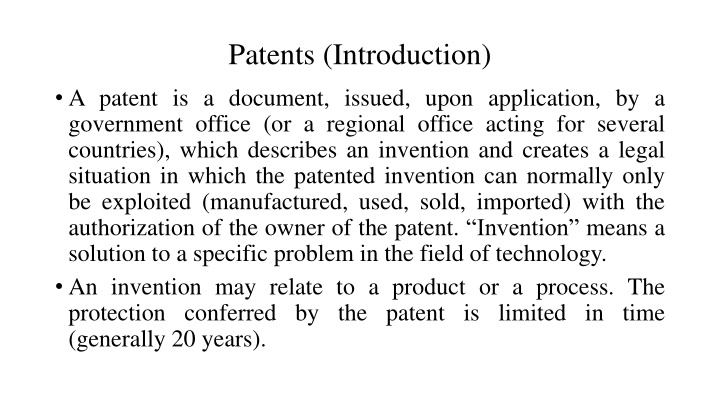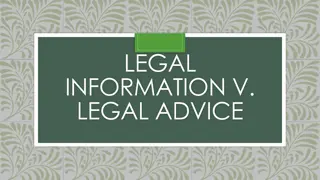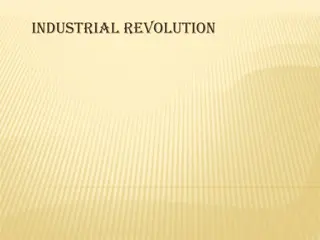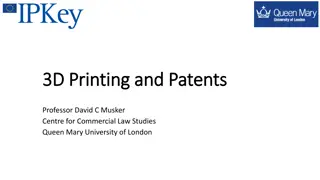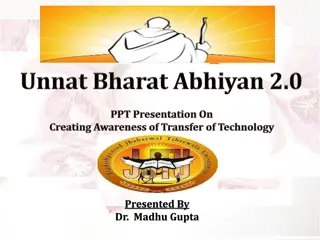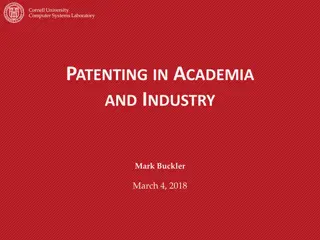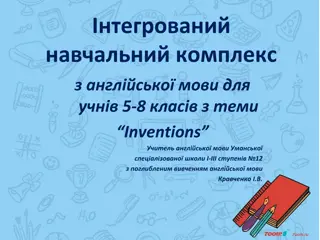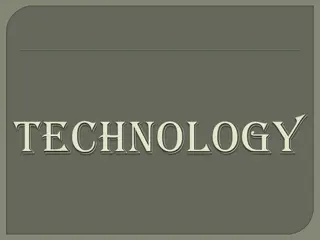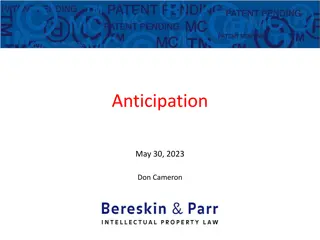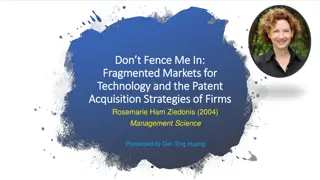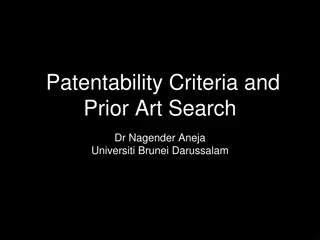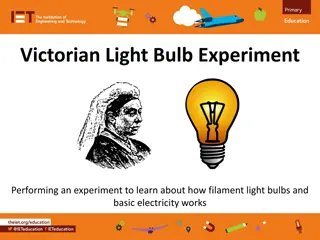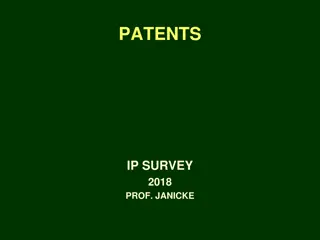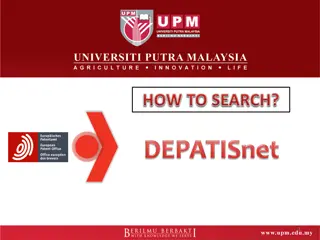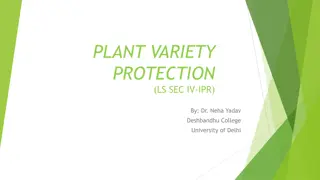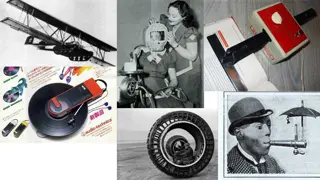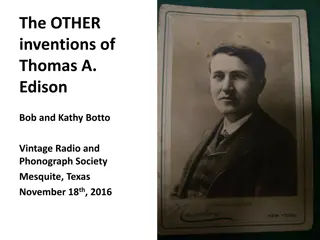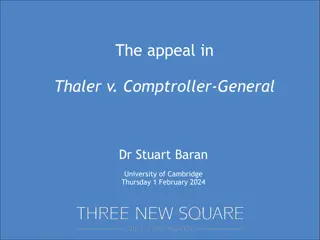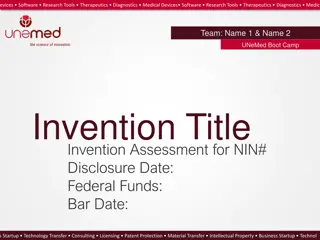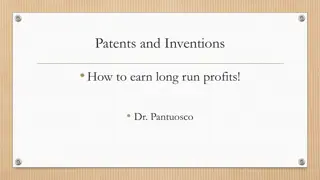Patents: Legal Protection for Inventions
A patent is a legal document issued by a government office that describes an invention and grants exclusive rights to the inventor for a limited time. It establishes the owner's authority to control the use, manufacture, and sale of the patented invention. Patents can be granted for products or processes, with the protection typically lasting around 20 years. In some countries, inventions can also be protected through utility models or short-term patents, offering similar rights with less stringent requirements and lower fees. The key benefit of a patent is the exclusive right to commercially exploit the invention, allowing the owner to prevent others from using it without consent. Patents are valuable assets that reward intellectual effort and innovation, providing inventors with recognition, economic incentives, and protection against unauthorized exploitation.
Download Presentation

Please find below an Image/Link to download the presentation.
The content on the website is provided AS IS for your information and personal use only. It may not be sold, licensed, or shared on other websites without obtaining consent from the author.If you encounter any issues during the download, it is possible that the publisher has removed the file from their server.
You are allowed to download the files provided on this website for personal or commercial use, subject to the condition that they are used lawfully. All files are the property of their respective owners.
The content on the website is provided AS IS for your information and personal use only. It may not be sold, licensed, or shared on other websites without obtaining consent from the author.
E N D
Presentation Transcript
Patents (Introduction) A patent is a document, issued, upon application, by a government office (or a regional office acting for several countries), which describes an invention and creates a legal situation in which the patented invention can normally only be exploited (manufactured, used, sold, imported) with the authorization of the owner of the patent. Invention means a solution to a specific problem in the field of technology. An invention may relate to a product or a process. The protection conferred by the patent is limited in time (generally 20 years).
Patents (Introduction) In a number of countries, inventions are also protectable through registration under the name of utility model or short-term patent. The requirements are somewhat less strict than for patents, in particular in respect of inventive step, and in comparison with patents the fees are lower, and the duration of protection is shorter, but otherwise the rights under the utility model or short-term patent are similar.
Patents (Introduction) are frequently monopolies , but a patent does not give the right to the inventor or the owner of a patented invention to make, use or sell anything. The effects of the grant of a patent are that the patented invention may not be exploited in the country by persons other than the owner of the patent unless the owner exploitation. Patents referred to as agrees to such
Patents Patents (Introduction) Thus, while the owner is not given a statutory right to practice his invention, he is given a statutory right to commercially exploiting his invention, which is frequently referred to as a right to exclude others from making, using or selling the invention. prevent others from
Patents Patents ( (Introduction Introduction) ) The right to take action against any person exploiting the patented invention in the country without his agreement constitutes the patent owner s most important right, since it permits him to derive the material benefits to which he is entitled as a reward for his intellectual effort and work, and compensation for the expenses which experimentation leading to the invention have entailed his research and
Patents (Introduction) It should be emphasized, however, that while the State may grant patent rights, it does not automatically enforce them, and it is up to the owner of a patent to bring an action, usually under civil law, for any infringement of his patent rights. The patentee must therefore be his own policeman.
Patents Patents (Introduction) Simply put, a patent is the right granted by the State to an inventor to exclude others from commercially exploiting the invention for a limited period, in return for the disclosure of the invention, so that others may gain the benefit of the invention. The disclosure of the invention is thus an important consideration in any patent granting procedure.
Conditions of patentability An invention must meet several criteria if it is to be eligible for patent protection. These include, most significantly, that the invention must consist of patentable subject matter, the invention must be industrially applicable (useful), it must be new (novel), it must exhibit a sufficient inventive step (be non- obvious), and the disclosure of the invention in the patent application must meet certain standards.
Conditions Conditions of of patentabilyty patentabilyty In order to be eligible for patent protection, an invention must fall patentable subject matter. Patentable subject matter is established by statute, and is usually defined in terms of patentability, the general rule being that patent protection shall be available for inventions in all fields of technology. within the scope of the exceptions to
Conditions of patentability Subject matter which may be excluded from patentability includes the following. Examples of fields of technology which may be excluded from the scope of patentable subject matter includes the following: - discoveries of materials or substances already existing in nature; - scientific theories or mathematical methods; - plants and animals other than microorganisms, and essentially production of plants and animals, other than non-biological and microbiological processes; - schemes, rules or methods, such as those for doing business, performing purely mental acts or playing games; - methods of treatment for humans or animals, or diagnostic methods practiced on humans or animals (but not products for use in such methods). biological processes for the
Conditions of patentability The TRIPS Agreement further specifies that Members may exclude from patent protection certain kinds of inventions, for instance inventions the commercial exploitation of which would contravene public order or morality.
Industrial Industrial Applicability Applicability (Utility) (Utility) An invention, in order to be patentable, must be of a kind which can be applied for practical purposes, not be purely theoretical. If the invention is intended to be a product or part of a product, it should be possible to make that product. And if the invention is intended to be a process or part of a process, it should be possible to carry that process out or use it (the general term) in practice. Applicability and industrial applicability are expressions reflecting, respectively, the manufacturing in practice, and that of carrying out or using in practice. possibility of making and
Industrial Industrial Applicability Applicability (Utility) (Utility) The term industrial should be considered in its broadest sense, including any kind of industry. In common language, an industrial activity means a technical activity on a certain scale, and the industrial applicability of an invention means the application (making use) of an invention by technical means on a certain scale. National and regional laws and practices concerning the industrial applicability requirement vary significantly.
Industrial Industrial Applicability Applicability (Utility) (Utility) At one end of the spectrum, the requirement of industrial applicability is met as long as the claimed invention can be made in industry without taking into account the use of the invention. At the other end of the spectrum, the usefulness of the claimed invention is taken into account for the determination of the industrial applicability. On the other hand, some countries do not require industrial applicability, but utility.
Novelty Novelty is a fundamental requirement in any examination as to substance and is an undisputed condition of patentability. It must be emphasized, however, that novelty is not something which can be proved or established; only its absence can be proved. An invention is new if it is not anticipated by the prior art. Prior art is, in general, all the knowledge that existed prior to the relevant filing or priority date of a patent application, whether it existed by way of written or oral disclosure. The question of what should constitute prior art at a given time is one which has been the subject of some debate.
Novelty One viewpoint is that the determination of prior art should be made against a background of what is known only in the protecting country. This would exclude knowledge from other countries, if it was not imported into the country before the making of the invention, even if that knowledge was available abroad before the date of the making of the invention. Another viewpoint is based on the differentiation between printed publications and other disclosures such as oral disclosures and prior use, and where such publications or disclosures occurred.
Novelty Novelty The disclosure of an invention so that it becomes part of the prior art may take place in three ways, namely: - by a description of the invention in a published writing or publication in other form; - by a description of the invention in spoken words uttered in public, such a disclosure being called an oral disclosure; - by the use of the invention in public, or by putting the public in a position that enables any member of the public to use it, such a disclosure being a disclosure by use.
Novelty Publication in tangible form requires that there be some physical carrier for the information, a document in the broad sense of the term, and that document must have been published, that is to say, made available to the public in any manner such as by offering for sale or deposit in a public collection. Publications include issued patents or published patent applications, writings (whether they be manuscript, typescript, or printed matter), pictures including photographs, drawings or films, and recording, whether they be discs or tapes in either spoken or coded language.
Novelty Novelty Today, increasingly be taken into consideration. publication on the Internet must Oral disclosure, as the expression suggests, implies that the words or form of the disclosure are not necessarily recorded as such and includes lectures and radio broadcasts
Novelty Disclosure by use is essentially a public, visual disclosure such as by display, sale, demonstration, unrecorded television broadcasts and actual public use. A document will only destroy the novelty of any invention claimed if the subject matter is explicitly contained in the document. Lack of novelty can only be found if the publication by itself contains all the characteristics of that claim, that is, if it anticipates the subject matter of the claim
Novelty Lack of novelty may however, be implicit in the publication in the sense that, in carrying out the publication, a person having ordinary skill in the art would inevitably arrive at a result falling within the terms of the claim. of the teaching
Novelty Novelty Generally speaking, lack of novelty of this kind will only be raised by the Patent Office where there is no reasonable doubt as to the practical effect of the prior teaching. It should be noted that in considering novelty, it is not permissible to combine separate items of prior art together.
Inventive Step Inventive Step In relation to the requirement of inventive step (also referred to as non-obviousness ), the question as to whether or not the invention would have been obvious to a person having ordinary skill in the art is perhaps the most difficult of the standards to determine in the examination as to substance. The inclusion of a requirement like this in patent legislation is based on the premise that protection should not be given to what is already known as part of the prior art, or to anything that the person with ordinary skill could deduce as an obvious consequence thereof.
Inventive Step (Non Inventive Step (Non- -Obviousness Obviousness) ) The expression ordinary skill is intended to exclude the best expert that can be found. It is intended that the person be limited to one having the average level of skill reached in the field in the country concerned.
Inventive Step (Non Inventive Step (Non- -Obviousness Obviousness) ) It should be noted that novelty and inventive step are different criteria. Novelty exists if there is any difference between the invention and the prior art. The question, is there inventive step? only arises if there is novelty. The expression inventive step conveys the idea that it is not enough that the claimed invention is new, that is, different from what exists in the state of the art, but that this difference must have two characteristics.
Inventive Step (Non Inventive Step (Non- -Obviousness Obviousness) ) Firstly, it must be inventive , that is, the result of a creative idea, and it must be a step, that is, it must be noticeable. There must be a clearly identifiable difference between the state of the art and the claimed invention. This is why, in some jurisdictions, there is the concept of an advance or progress over the prior art
Inventive Step (Non Inventive Step (Non- -Obviousness Obviousness) ) Secondly, it is required that this advance or progress be significant and essential to the invention. In order to assess the nature of the differences which are relied upon inventive step, account has to be taken of the prior art as a whole. as constituting an
Inventive Step (Non Inventive Step (Non- -Obviousness Obviousness) ) Thus, as distinct from the assessment of novelty, the subject matter of the claim under examination is compared not with each publication or other disclosure separately, but with the combinations thereof, insofar as each such combination is obvious to the person having ordinary skill in the art. The combination may be global, whereas the claim may define a set of subject matter known separately, for instance a new form of washing machine including a particular type of motor coupled to a particular type of pump.
Inventive Step (Non Inventive Step (Non- -Obviousness Obviousness) ) For the inventive step to be denied, it is necessary that not only the combination, but also the choice of the combined elements, is obvious. It is the sum of the differences that have been discovered which must be compared with the prior art and judged as to obviousness, and not each of the new elements taken individually, except where there is no technical link between them.
Inventive Step (Non Inventive Step (Non obviousness In most cases, it is useful to assess inventive step in relation to three aspects, namely: - the problem to be solved; - the solution to that problem; and - the advantageous effects, if any, of the invention with reference to the background art. obviousness) )
Inventive Step (Non Inventive Step (Non obviousness obviousness) ) If the problem is known or obvious, the examination will bear on the originality of the solution claimed. If no inventive step is found in the solution, the question becomes whether or not the result is obvious or whether it is surprising either by its nature or by its extent. If a person having ordinary skill in the art would have been able to pose the problem, solve it in the manner claimed, and foresee the result, the inventive step is lacking
Disclosure of the Disclosure of the Invention An additional requirement of patentability is whether or not the invention is sufficiently disclosed in the application. The application must disclose the invention in a manner sufficiently clear for the invention to be carried out by a person skilled in the art. Invention
Disclosure of the Disclosure of the Invention Invention The description should set out at least one mode for carrying out the invention claimed. This should be done in terms of examples, where appropriate, and with reference to the drawings, if any.
Disclosure of the Disclosure of the Invention Invention In some countries, the description is required to disclose the best mode for carrying out the invention known to the applicant. Whether or not there is an examination as to substance, some jurisdictions opposition procedure which may be instituted either before or after the grant of a patent. An opposition procedure is designed to allow third parties to present objections to the grant of a patent. provide for an
Disclosure of the Disclosure of the Invention So that oppositions may be filed, the public must be informed of the content of the application, and this is done by the Patent Office by publication of a notice in an official journal or gazette to the effect that: - the application is open to public inspection; and/or - the Patent Office will, unless opposition is filed within a prescribed period, grant a patent; or - a patent has been granted on the application. Invention
Disclosure of Disclosure of Invention Invention The grounds upon which an opposition may be filed are prescribed by the relevant legislation. Generally speaking, it should be possible for an opposition to be based on non-compliance with requirement. However, the law in some countries restricts an opposition to requirements only. any substantive certain substantive
Disclosure of Disclosure of Invention Invention Typically these grounds are lack of novelty, inventive step or industrial applicability, insufficient disclosure of the invention, or the fact that an amendment made to a patent application has gone beyond the original disclosure in the application as filed. Some jurisdictions make it possible to file an opposition on the ground that the applicant has no right to a patent.
Drafting and Filing a Patent Application Drafting and Filing a Patent Application The first task in drafting a patent application is the identification of the invention. This involves: - summarizing all the necessary features which in combination solve a particular technical problem; and an examination of this combination to determine whether it would, according to one s own judgment, fulfill the requirements for patentability, especially inventive step.
Identification Identification of the It is during this process that a full comprehension of the essence of the invention is obtained, and this is important in helping to draft the description and claims. Often the invention contains more than one new feature. It is essential to identify the critical feature or features and to have an explanation of why they contribute to an effective solution to the problem. There are two important reasons for this. First, the claims should be as broad as possible; the broadest claim is the one restricted by the least number of features. of the Invention Invention
Identification Identification of the of the invention invention Second, having identified the critical features and their effect, it is then necessary to ask how else may this effect be achieved, that is, can the specific features be substituted or altered while still achieving the end result. This is important not only in drafting the claims, which must be wide enough to cover these substitutes or alternatives, but also in the description of the invention which must include details of the substitutes or alternatives so that the broad claim can be supported by the description.
Practical Aspects of Drafting Patent Applications Practical Aspects of Drafting Patent Applications Drafting practices and requirements differ from country to country. However, there are typically three basic requirements to be complied with in the drafting of a patent application. Firstly, there is a requirement that the application should relate to one invention only, or to a group of inventions so linked as to form a single general inventive concept. This requirement, referred to as unity of invention , is particularly important when claims are being drafted.
Practical Aspects of Drafting Patent Applications Practical Aspects of Drafting Patent Applications Secondly, the description should disclose the invention in a manner sufficiently clear and complete for the invention to be evaluated, and to be carried out by a person having ordinary skill in the art. This importance, since one of the main functions of the description is to provide new technical information to third parties. is of fundamental
Practical Aspects of Drafting Patent Applications An important phrase to note in this requirement is a person having ordinary skill in the art. This allows for a simplified description since it can be assumed that the reader will be an informed reader having the background knowledge which makes it unnecessary to describe every basic detail of the invention.
Practical Aspects of Drafting Patent Applications Practical Aspects of Drafting Patent Applications Thirdly, for the application to proceed, it must contain claims which determine the scope of the protection. The claims must be clear and concise and fully supported by the description. This third important since the claims are the basis of interpretation of patent protection. It is from the claims that third parties are able to know what they may do and what they may not do. The claims may not be significantly broader or different from that which has been described. basic requirement is
Practical Aspects of Drafting Patent Applications Practical Aspects of Drafting Patent Applications The first section of the description typically contains two elements, namely, the title of the invention and a brief statement of the technical field in which the invention lies. Usually this statement is in the form of a short introductory paragraph which commences with the phrase This invention relates to ......
Practical Aspects of Drafting Patent Applications Practical Aspects of Drafting Patent Applications In the second section, the background of the invention is described. In drafting this section, the patent agent usually problems or difficulties which the invention overcomes. Any previous solutions to those problems or difficulties should be described, preferably in a way which clearly sets out the difference between the present and previous solutions. sets out any existing
Practical Aspects of Drafting Patent Applications Practical Aspects of Drafting Patent Applications This section may also describe the object of the invention, that is to say, what the invention sets out to achieve. The second section of the description is important to provide a good understanding of the invention and to put it into perspective against the prior art.
Practical Aspects of Drafting Patent Applications Practical Aspects of Drafting Patent Applications The third section of the description provides a summary of the invention in such terms that it may be readily understood. The patent agent will normally describe the invention first in general terms which correspond to those he intends to use in the main claim. By using this technique, the agent can avoid any disputes that might arise based on differences between the invention described and the invention as defined in the claims.
Practical Aspects of Drafting Patent Applications Practical Aspects of Drafting Patent Applications This description of the invention in general terms is usually followed by a series of paragraphs which set out different preferred invention. These form the basis for dependent claims which follow the broad main claim. features paragraphs of usually the
Practical Aspects of Drafting Patent Applications In the fourth section of the description, two elements are generally found, namely a brief description of the drawings, if drawings are appropriate, and a detailed description of one or more embodiments of the invention. If the invention relates to some form of mechanical object, for example, drawings illustrating plan, elevation and sectional views of that object could be used. Elements of the drawings which are described are numbered in the drawings and these numbers utilized in the description of the embodiment.
